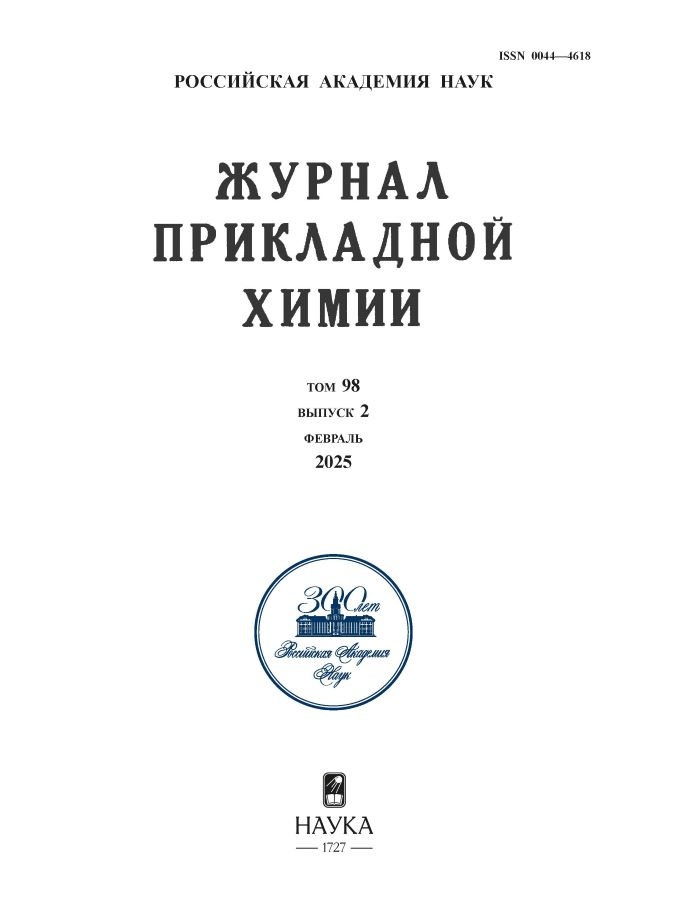Приготовление безводных растворов перхлората магния в сульфолане
- Authors: Голубятникова Л.Г.1, Мишинкин В.Ю.1, Шеина Л.В.1, Кузьмина Е.В.1
-
Affiliations:
- Уфимский федеральный исследовательский центр РАН
- Issue: Vol 98, No 2 (2025)
- Pages: 111-115
- Section: Неорганический синтез и технология неорганических производств
- URL: https://clinpractice.ru/0044-4618/article/view/686388
- DOI: https://doi.org/10.31857/S0044461825020037
- EDN: https://elibrary.ru/KKPZCV
- ID: 686388
Cite item
Abstract
В работе исследовано влияние условий осушки Mg(ClO4)2 на содержание остаточной воды в соли и в растворах соли в сульфолане. Установлено, что полное удаление кристаллизационной воды из Mg(ClO4)2 происходит при температуре выше 380°C и сопровождается частичным разложением соли. При удалении воды при 150°C в вакууме образуется дигидрат, а при 250°C — моногидрат. Содержание воды в 0.7 M растворе Mg(ClO4)2, полученном путем растворения моногидрата в сульфолане, составило ~9000 ppm. Удаление воды из раствора Mg(ClO4)2 в сульфолане до приемлемых значений (ниже 60 ppm) может быть достигнуто отгонкой азеотропной смеси вода–сульфолан–бензол с последующей дополнительной осушкой раствора металлическим литием.
Full Text
About the authors
Людмила Григорьевна Голубятникова
Уфимский федеральный исследовательский центр РАН
Email: kuzmina@anrb.ru
ORCID iD: 0000-0001-9900-8587
Уфимский институт химии, к.х.н.
Russian Federation, 450054, г. Уфа, пр. Октября, д. 71Вадим Юрьевич Мишинкин
Уфимский федеральный исследовательский центр РАН
Email: kuzmina@anrb.ru
ORCID iD: 0000-0003-0661-0400
Уфимский институт химии, к.х.н.
Russian Federation, 450054, г. Уфа, пр. Октября, д. 71Людмила Владимировна Шеина
Уфимский федеральный исследовательский центр РАН
Email: kuzmina@anrb.ru
ORCID iD: 0000-0002-9156-0139
Уфимский институт химии, к.х.н.
Russian Federation, 450054, г. Уфа, пр. Октября, д. 71Елена Владимировна Кузьмина
Уфимский федеральный исследовательский центр РАН
Author for correspondence.
Email: kuzmina@anrb.ru
ORCID iD: 0000-0002-3758-4762
Уфимский институт химии, к.х.н.
Russian Federation, 450054, г. Уфа, пр. Октября, д. 71References
- Saha P., Datta M. K., Velikokhatnyi O. I., Manivannan A., Alman D., Kumta P. N. Rechargeable magnesium battery: Current status and key challenges for the future // Prog. Mater. Sci. 2014. V. 66. P. 1–86. https://doi.org/10.1016/j.pmatsci.2014.04.001
- Bucur C. B. Challenges of a rechargeable magnesium battery. A guide to the viability of this post lthium-ion battery. Springer, Switzerland, 2018. 67 p. https://doi.org/10.1007/978-3-319-65067-8
- Venkata Narayanan N. S., Ashok Raj B. V., Sampath S. Magnesium ion conducting, room temperature molten electrolytes // Electrochem. Commun. 2009. V. 11. N 10. P. 2027–2031. https://doi.org/10.1016/j.elecom.2009.08.045
- Keyzer E. N., Glass F. J., Bayley P. M., Dutton S. E., Grey C. P., Wright D. S. Mg(PF6)2-based electrolyte systems: Understanding electrolyte–electrode interactions for the development of Mg-ion batteries // J. Am. Chem. Soc. 2016. V. 138. P. 8682−8685. https://doi.org/10.1021/jacs.6b04319
- Микрюкова М. А., Агафонов Д. В. Сравнение традиционных органических растворителей с эфирами фосфорной кислоты в литий-ионных и суперконденсаторных системах // Электрохим. энергетика. 2015. Т. 15. № 3. С. 111–118. https://www.elibrary.ru/whoupl
- Pekmez K., Can M., Yildiz A. Electrochemistry in aprotic solvents containing anhydrous perchloric acid: Electroreduction behavior of quinones // Electrochim. Acta. 1993. V. 38. P. 607–611. https://doi.org/10.1016/0013-4686(93)85020-Y
- McEwen A. B., Ngo H. L., LeCompte K., Goldman J. L. Electrochemical properties of imidazolium salt electrolytes for electrochemical capacitor applications // J. Electrochem. Soc. 1999. V. 146. P. 1687–1695. https://doi.org/10.1149/1.1391827
- Lossius L. P., Emmenegger F. Plating of magnesium from organic solvents // Electrochim. Acta. 1996. V. 41. P. 445–447. https://doi.org/10.1016/0013-4686(95)00326-6
- Gofer Y., Pour N., Aurbach D. Electrolytic solutions for rechargeable magnesium batteries. Hoboken, NJ: Wiley, 2013. P. 327–347. https://doi.org/10.1002/9781118615515.ch15
- Shao N., Sun X.-G., Dai S. Electrochemical windows of sulfone-based electrolytes for high-voltage Li-ion batteries // J. Phys. Chem. B. 2011. V. 115. N 42. P. 12120–12125. https://doi.org/10.1021/jp204401t
- Wu F., Zhou H., Bai Y., Wang H., Wu C. Toward 5 V Li-ion batteries: Quantum chemical calculation and electrochemical characterization of sulfone-based high-voltage electrolytes // ACS Appl. Mater. Interfaces. 2015. V. 7. N 27. P. 15098–15107. https://doi.org/10.1021/acsami.5b04477
- Jow T. R., Xu K., Borodin O., Ue M. Electrolytes for lithium and lithium-ion batteries. New York; Heidelberg; Dordrecht; London, 2014. P. 61, 94, 192. https://doi.org/10.1007/978-1-4939-0302-3
- Pat. CN105811001A (publ. 2016). Sulfolane based binary sodium ion electrolyte and preparation method thereof.
- Колосницын В. С., Шеина Л. В., Мочалов С. Э. Физико-химические и электрохимические свойства растворов литиевых солей в сульфолане // Электрохимия. 2008. Т. 44. С. 620‒623. https://www.elibrary.ru/ijuwuz [Kolosnitsyn V. S., Sheina L. V., Mochalov S. E. Physicochemical and electrochemical properties of sulfolane solutions of lithium salts // Russ. J. Electrochem. 2008. V. 44. N 5. P. 575‒578. https://doi.org/10.1134/S102319350805011X].
- Шеина Л. В., Карасева Е. В., Колосницын В. С. Физико-химические свойства растворов перхлората натрия в сульфолане // Журн. физ. химии. 2021. T. 95. C. 780‒786. https://doi.org/10.31857/S0044453721050241 [Sheina L. V., Karaseva E. V., Kolosnitsyn V. S. Physical and chemical properties of sodium perchlorate solutions in sulfolane // Russ. J. Phys. Chem. A. 2021. V. 95. N 5. P. 983–989. https://doi.org/10.1134/S003602442105023X].
- Karaseva E. V., Kuzmina E. V., Kolosnitsyn D. V., Shakirova N. V., Sheina L. V., Kolosnitsyn V. S. The mechanism of effect of support salt concentration in electrolyte on performance of lithium-sulfur cells // Electrochim. Acta. 2019. V. 296. P. 1102‒1114. https://doi.org/10.1016/j.electacta.2018.11.019
- Senoh H., Sakaebe H., Sano H., Yao M., Kuratani K., Takeichi N., Kiyobayashi T. Sulfone-based electrolyte solutions for rechargeable magnesium batteries using 2,5-dimethoxy-1,4-benzoquinone positive electrode // J. Electrochem. Soc. 2014. V. 161. P. A1315‒A1320. https://doi.org/10.1149/2.0531409jes
- Mandai T., Yao M., Sodeyama K., Kagatsume A., Tateyama Y., Imai H. Toward improved anodic stability of ether-based electrolytes for rechargeable magnesium batteries // J. Phys. Chem. C. 2023. V. 127. P. 10419‒10433. https://doi.org/10.1021/acs.jpcc.3c01452
- Copeland L. E., Bragg R. H. The hydrates of magnesium perchlorate // Thermochim. Acta. 1954. V. 58. N 12. P. 1075–1077. https://doi.org/10.1021/j150522a007
- Bradley D., Williams G., Lawton M. Drying of organic solvents: Quantitative evaluation of the efficiency of several desiccants // J. Org. Chem. 2010. V. 75. P. 8351–8354. https://doi.org/10.1021/jo101589h
- Mahdi T., Ahmad A., Nasef M., Ripin A. State-of-the-art technologies for separation of azeotropic mixtures // Sep. Purif. Rev. 2015. V. 44. P. 308–330. https://doi.org/10.1080/15422119.2014.963607
Supplementary files












